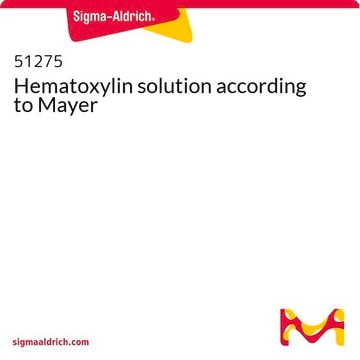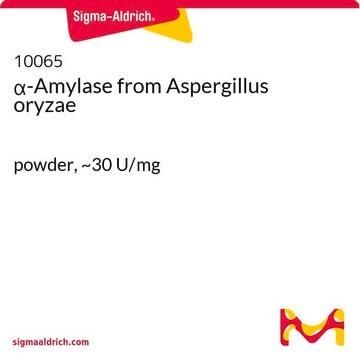The nuclei will originally appear as the same color as the solution. Only after the slides have been "blued" will the nuclei appear blue. The pH of the solution is acidic. This acidic pH promotes specific staining. However the slides must be washed in an neutral or alkaline solution for the color to shift to blue. Prolonged warm water washes in tap water are often sufficient for the bluing to occur. To shorten the time spent in washing, various bluing agents are often used to shorten the blueing process. Scott's Tap Water Substitute (Product No. S5134) is one such blueing agent.
MHS1
Mayer′s Hematoxylin Solution
Scegli un formato
Scegli un formato
About This Item
Prodotti consigliati
Stato
solution
Durata
Expiry date on the label.
IVD
for in vitro diagnostic use
Concentrazione
1 g/L
pH
2.4 (25 °C)
applicazioni
hematology
histology
Temperatura di conservazione
room temp
Stringa SMILE
Oc1cc2C[C@@]3(O)COc4c(O)c(O)ccc4[C@H]3c2cc1O
InChI
1S/C16H14O6/c17-10-2-1-8-13-9-4-12(19)11(18)3-7(9)5-16(13,21)6-22-15(8)14(10)20/h1-4,13,17-21H,5-6H2/t13-,16+/m0/s1
WZUVPPKBWHMQCE-XJKSGUPXSA-N
Cerchi prodotti simili? Visita Guida al confronto tra prodotti
Descrizione generale
Applicazioni
Altre note
Codice della classe di stoccaggio
12 - Non Combustible Liquids
Classe di pericolosità dell'acqua (WGK)
WGK 2
Punto d’infiammabilità (°F)
Not applicable
Punto d’infiammabilità (°C)
Not applicable
Scegli una delle versioni più recenti:
Possiedi già questo prodotto?
I documenti relativi ai prodotti acquistati recentemente sono disponibili nell’Archivio dei documenti.
I clienti hanno visto anche
Protocolli
Use this protocol to for the entire immunohistochemistry (IHC) procedure through staining and visualization of specific antigens in paraffin-embedded tissue sections.
-
The slides were stained with Mayer's Hematoxylin but the nuclei are not blue. Why?
1 risposta-
Utile?
-
-
What is the Department of Transportation shipping information for this product?
1 risposta-
Transportation information can be found in Section 14 of the product's (M)SDS.To access the shipping information for this material, use the link on the product detail page for the product.
Utile?
-
-
There are several Mayer's Hematoxylins listed on the website, beginning with the letters MHS. What are the differences?
1 risposta-
Products MHS1, MHS16, MHS32, MHS80 and MHS128 are in fact the same product. In this case a unique product number was assigned to each package size. Other than the package size, there are no differences in formulation or use.
Utile?
-
-
The website states that Mayer's Hematoxylin solution is a progressive type hematoxylin. What is a progressive type hematoxylin?
1 risposta-
Hematoxylin solutions are generally classified as either progressive or regressive. Progressive formulations will stain only the nucleus. No staining should occur within the cytoplasm. Regressive hematoxylins have higher dye contents and if used for sufficient periods of time will overstain both the nucleus and the cytoplasm. Acid differentiation is required to remove the excessive stain from the cytoplasm and nucleus. This differentiation take practice to master. Too much or too little stain can be removed during differentiation, resulting in poorly stained slides. For users lacking extensive experience with the Hematoxylin and Eosin staining procedure, progressive hematoxylin formulations are often the better choice.
Utile?
-
-
There is also a product listed on the website as Hematoxylin Solution According to Mayer. What is the difference between product 51275 and the various Mayer's Hematoxylin solutions?
1 risposta-
The basic formulations are the same. Both include chloral hydrate, although some of the concentrations could vary slightly. Product 51275 is not intended for In Vitro Diagnostic Use. Product 51275 is not CE Marked. The various Mayer's Hematoyxlin solutions are intended For In Vitro Diagnostic Use and are also CE Marked. Product inserts are available for various languages.
Utile?
-
-
Is chloral hydrate used in the preparation of Mayer's Hematoxylin? Does this mean the solution is controlled as a DEA Schedule IV product?
1 risposta-
Yes, chloral hydrate is included in the formulation. No, the solution is not controlled as a DEA Schedule IV product. Once the choral hydrate is mixed with the remaining chemicals, it is impossible to obtain the chloral hydrate in a purified form.
Utile?
-
Filtri attivi
Il team dei nostri ricercatori vanta grande esperienza in tutte le aree della ricerca quali Life Science, scienza dei materiali, sintesi chimica, cromatografia, discipline analitiche, ecc..
Contatta l'Assistenza Tecnica.









